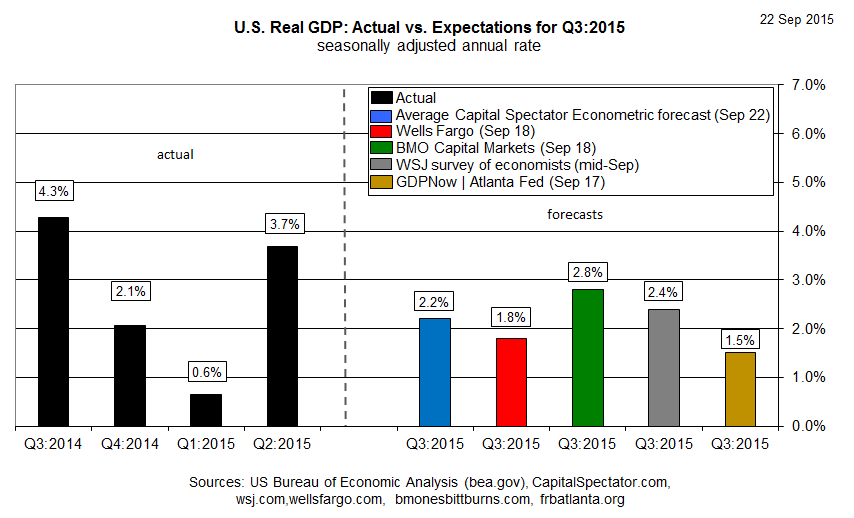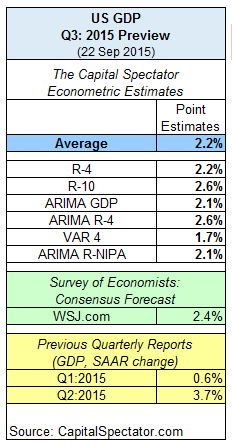The evidence is mounting that the US GDP report for the third quarter that’s due next month will reflect substantially slower growth vs. Q2’s strong 3.7% rise (seasonally adjusted annual rate). The mystery at this point is the degree of deceleration.
Current projections cast a wide net for Q3. On the low end is the Atlanta Fed’s GDPNow model, which projects a tepid 1.5% increase as of Sep. 17. On the high end is BMO Capital Markets’ outlook for a 2.8% increase. As for the crowd overall, The Wall Street Journal’s September survey of economists reflects an average Q3 rise of 2.4%.
Meanwhile, the Capital Spectator’s average Q3 GDP estimate via several econometric forecasts ticked up to 2.2% from last month’s 2.1% estimate.
The guessing game for the current quarter ends on Oct. 29, when the Bureau of Economic Analysis publishes its “advance” GDP estimate for Q3.
Worries about the potential for blowback from China’s slowdown have raised uncertainty about the strength of the US macro trend—uncertainty that appears to have convinced the Federal Reserve to delay raising interest rates last week. But Atlanta Fed President Dennis Lockhart yesterday said that a rate hike at next month’s policy meeting was a possibility:
Market volatility, if protracted, can be a channel for damping forces on economic activity. It’s too early to detect any significant impact on the real economy, to know whether any or all the factors I cited will evolve into a significant headwind.
For now, the available data shows that the “the economy is performing solidly,” Lockhart advised. “As things settle down, I will be ready for the first policy move on the path to a more normal interest-rate environment. I am confident the much-used phrase ‘later this year’ is still operative” for raising rates.
Nonetheless, there’s widespread agreement that the pace of growth is on track for a substantial slowdown in Q3 vs. the previous quarter’s impressive gain. But with the final month of Q3 numbers still missing, there’s still plenty of uncertainty about how the final round of figures will compare.
Here’s a summary of The Capital Spectator’s Q3:2015 average estimate vs. recent history and forecasts from various sources:
Here are the various forecasts that are used to calculate CapitalSpectator.com’s average estimate:
As updated estimates are published, based on incoming economic data, the chart below tracks the changes in the evolution of The Capital Spectator’s projections.
Finally, here’s a brief profile for each of The Capital Spectator’s GDP forecast methodologies:
R-4: This estimate is based on a multiple regression in R of historical GDP data vs. quarterly changes for four key economic indicators: real personal consumption expenditures (or real retail sales for the current month until the PCE report is published), real personal income less government transfers, industrial production, and private non-farm payrolls. The model estimates the statistical relationships from the early 1970s to the present. The estimates are revised as new data is published.
R-10: This model also uses a multiple regression framework based on numbers dating to the early 1970s and updates the estimates as new data arrives. The methodology is identical to the 4-factor model above, except that R-10 uses additional factors—10 in all—to forecast GDP. In addition to the data quartet in the 4-factor model, the 10-factor forecast also incorporates the following six series: ISM Manufacturing PMI Composite Index, housing starts, initial jobless claims, the stock market (Wilshire 5000), crude oil prices (spot price for West Texas Intermediate), and the Treasury yield curve spread (10-year Note less 3-month T-bill).
ARIMA GDP: The econometric engine for this forecast is known as an autoregressive integrated moving average. This ARIMA model uses GDP’s history, dating from the early 1970s to the present, for anticipating the target quarter’s change. As the historical GDP data is revised, so too is the forecast, which is calculated in R via the “forecast” package, which optimizes the parameters based on the data set’s historical record.
ARIMA R-4: This model combines ARIMA estimates with regression analysis to project GDP data. The ARIMA R-4 model analyzes four historical data sets: real personal consumption expenditures, real personal income less government transfers, industrial production, and private non-farm payrolls. This model uses the historical relationships between those indicators and GDP for projections by filling in the missing data points in the current quarter with ARIMA estimates. As the indicators are updated, actual data replaces the ARIMA estimates and the forecast is recalculated.
VAR 4: This vector autoregression model uses four data series in search of interdependent relationships for estimating GDP. The historical data sets in the R-4 and ARIMA R-4 models noted above are also used in VAR-4, albeit with a different econometric engine. As new data is published, so too is the VAR-4 forecast. The data sets range from the early 1970s to the present, using the “vars” package in R to crunch the numbers.
ARIMA R-NIPA: The model uses an autoregressive integrated moving average to estimate future values of GDP based on the datasets of four primary categories of the national income and product accounts (NIPA): personal consumption expenditures, gross private domestic investment, net exports of goods and services, and government consumption expenditures and gross investment. The model uses historical data from the early 1970s to the present for anticipating the target quarter’s change. As the historical numbers are revised, so too is the estimate, which is calculated in R via the “forecast” package, which optimizes the parameters based on the data set’s historical record.



Pingback: Slower Growth Expected for Third Quarter